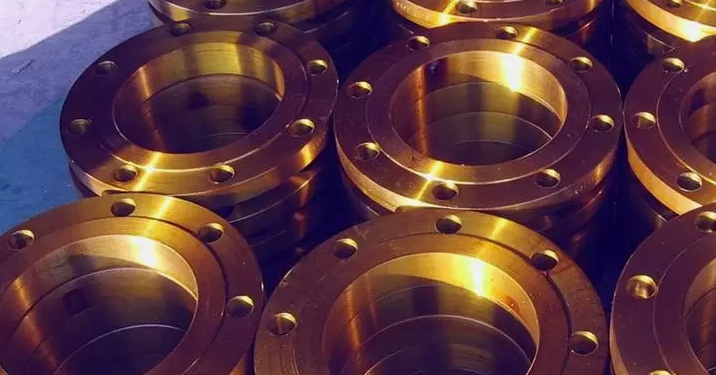Marine engineering requires materials that can withstand extreme environments while offering exceptional strength and resistance to corrosion. Among the many materials available, Copper Nickel 90:10 flanges stand out as a reliable choice for seawater applications, offshore structures, and shipbuilding projects. With a balanced combination of copper (90%) and nickel (10%), these flanges provide durability, ease of fabrication, and excellent resistance to biofouling and stress corrosion. This blog explores the properties, advantages, and industrial significance of Copper Nickel 90:10 flanges in marine engineering projects.
Introduction to Copper Nickel 90:10 Flanges
Copper Nickel alloys, also known as Cu-Ni alloys, are highly regarded in industries where both strength and corrosion resistance are critical. The 90:10 composition is widely used because it provides the right balance between cost-effectiveness and performance. In this alloy, copper forms the base while nickel enhances the material’s resistance to seawater corrosion and stress cracking.
Flanges made from this alloy serve as essential connectors in piping systems, enabling secure joining, sealing, and maintenance of pipelines carrying seawater, chemicals, and other fluids. Their application in marine projects highlights their ability to function reliably under challenging conditions where ordinary stainless steel or carbon steel flanges may fail.
Key Properties of Copper Nickel 90:10 Flanges
- Exceptional Corrosion Resistance
- These flanges resist pitting, crevice corrosion, and stress corrosion cracking in seawater environments.
- They naturally form a protective oxide layer, which minimizes degradation over time.
- Resistance to Biofouling
- Marine environments often face problems due to algae, barnacles, and other organisms attaching to surfaces.
- Copper Nickel alloys deter biofouling, reducing maintenance and ensuring smooth flow within pipelines.
- High Thermal Stability
- Cu-Ni flanges can operate effectively at high and low temperatures, making them suitable for heat exchangers, condensers, and engine cooling systems.
- Mechanical Strength
- They offer reliable strength for demanding applications, including offshore oil rigs and naval vessels.
- Their ductility allows for easy fabrication into complex designs.
- Longevity
- Unlike conventional materials, these flanges retain their mechanical and anti-corrosion properties over decades, reducing long-term replacement costs.
Applications in Marine Engineering
Copper Nickel 90:10 flanges are indispensable in industries directly connected to seawater exposure and marine operations. Some of their most significant applications include:
1. Shipbuilding Industry
- Used in cooling seawater systems, fire-fighting pipelines, and bilge systems.
- Provide durability for long voyages where maintenance opportunities are limited.
2. Offshore Oil and Gas Platforms
- Protect piping systems that constantly interact with seawater.
- Ensure durability in transporting oil, gas, and seawater injection lines.
3. Desalination Plants
- Cu-Ni flanges are widely used in desalination plants for seawater intake and brine discharge systems.
- Their ability to resist salt-related corrosion makes them more reliable than standard steel options.
4. Naval and Defense Applications
- Military ships and submarines employ these flanges due to their superior resistance to stress cracking under pressure.
- They ensure uninterrupted service in critical defense infrastructure.
5. Power Generation Plants
- Used in condensers and heat exchangers that utilize seawater for cooling.
- Their ability to handle continuous cycles of heating and cooling extends system life.
Benefits of Using Copper Nickel 90:10 Flanges
- Enhanced Service Life
- The resistance to seawater corrosion significantly prolongs the service life of piping systems.
- Lower Maintenance Requirements
- Reduced biofouling and corrosion result in minimal cleaning, inspection, and replacement needs.
- Cost-Effectiveness in the Long Run
- Though the initial investment may be higher than carbon steel, the extended lifespan ensures cost savings over time.
- Reliability in Harsh Conditions
- From deep-sea environments to high-pressure systems, these flanges maintain consistent performance.
- Compatibility with Other Alloys
- Copper Nickel alloys are often combined with other materials without causing galvanic corrosion, making them versatile for engineering projects.
Manufacturing and Standards
Copper Nickel 90:10 flanges are manufactured according to global standards to ensure reliability and compatibility across projects. Some commonly followed specifications include:
- ASTM B151 – Covers Cu-Ni alloys for flanges and fittings.
- ASME/ANSI B16.5 – For pipe flanges and flanged fittings.
- DIN Standards – Widely used in European marine and engineering industries.
The flanges are available in different types such as slip-on flanges, weld neck flanges, blind flanges, and socket weld flanges, each serving specific engineering needs.
Challenges and Considerations
While Copper Nickel 90:10 flanges offer numerous benefits, certain considerations should be kept in mind:
- Higher Initial Cost – They are more expensive than carbon steel flanges. However, their durability offsets this over the long term.
- Specialized Fabrication Skills Required – Welding and machining need expertise to maintain material integrity.
- Availability – Depending on the region, sourcing the exact flange type might take additional lead time.
Conclusion
Marine engineering projects demand materials that combine strength, durability, and resistance to harsh environments. Copper Nickel 90:10 flanges meet these requirements by delivering outstanding performance in seawater applications, shipbuilding, offshore platforms, and desalination plants. Their ability to resist corrosion, reduce biofouling, and maintain mechanical integrity makes them one of the most reliable flange materials for long-term service.
By choosing Copper Nickel 90:10 flanges, industries can ensure not just operational efficiency but also significant cost savings in the long run. Whether it’s powering naval defense systems, constructing offshore oil rigs, or supporting commercial shipping lines, these flanges remain the backbone of reliable marine infrastructure.












